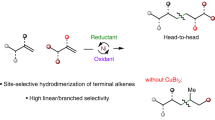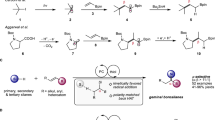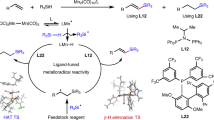Abstract
Because of the importance of hydrogen atom transfer (HAT) in biology and chemistry, there is increased interest in new strategies to perform HAT in a sustainable manner. Here, we describe a sustainable, net redox-neutral HAT process involving hydrosilanes and alkali metal Lewis base catalysts—eliminating the use of transition metal catalysts—and report an associated mechanism concerning Lewis base-catalysed, complexation-induced HAT. The catalytic Lewis base-catalysed, complexation-induced HAT is capable of accessing both branch-specific hydrosilylation and polymerization of vinylarenes in a highly selective fashion, depending on the Lewis base catalyst used. In this process, the Earth-abundant, alkali metal Lewis base catalyst plays a dual role. It first serves as a HAT initiator and subsequently functions as a silyl radical stabilizing group, which is critical to highly selective cross-radical coupling. An electron paramagnetic resonance study identified a potassiated paramagnetic species, and multistate density functional theory revealed a high HAT character, yet multiconfigurational nature in the transition state of the reaction.
This is a preview of subscription content, access via your institution
Access options
Access Nature and 54 other Nature Portfolio journals
Get Nature+, our best-value online-access subscription
$29.99 / 30 days
cancel any time
Subscribe to this journal
Receive 12 digital issues and online access to articles
$119.00 per year
only $9.92 per issue
Buy this article
- Purchase on Springer Link
- Instant access to full article PDF
Prices may be subject to local taxes which are calculated during checkout







Similar content being viewed by others
Data availability
All data supporting the findings of this study, including experimental details, spectroscopic characterization data for all compounds, and computational details, are available within the paper and its Supplementary Information, or from the corresponding author upon reasonable request.
References
Eisenberg, D. C. & Norton, J. R. Hydrogen‐atom transfer reactions of transition‐metal hydrides. Isr. J. Chem. 31, 55–66 (1991).
Kumar, M., Sinha, A. & Francisco, J. S. Role of double hydrogen atom transfer reactions in atmospheric chemistry. Acc. Chem. Res. 49, 877–883 (2016).
Mukaiyama, T. & Yamada, T. Recent advances in aerobic oxygenation. Bull. Chem. Soc. Jpn 68, 17–35 (1995).
Crossley, S. W., Obradors, C., Martinez, R. M. & Shenvi, R. A. Mn-, Fe-, and Co-catalyzed radical hydrofunctionalizations of olefins. Chem. Rev. 116, 8912–9000 (2016).
Mayer, J. M. Hydrogen atom abstraction by metal−oxo complexes: understanding the analogy with organic radical reactions. Acc. Chem. Res. 31, 441–450 (1998).
Guallar, V., Baik, M.-H., Lippard, S. J. & Friesner, R. A. Peripheral heme substituents control the hydrogen-atom abstraction chemistry in cytochromes P450. Proc. Natl Acad. Sci. USA 100, 6998–7002 (2003).
Nakajima, Y. & Shimada, S. Hydrosilylation reaction of olefins: recent advances and perspectives. RSC Adv. 5, 20603–20616 (2015).
Docherty, J. H., Peng, J., Dominey, A. P. & Thomas, S. P. Activation and discovery of earth-abundant metal catalysts using sodium tert-butoxide. Nat. Chem. 9, 595–600 (2017).
Tilset, M. in Comprehensive Organometallic Chemistry III Vol. 1 (eds Crabtree R. H. & Mingos, D. M. P.) 279–305 (Elsevier, 2007).
Wiedner, E. S. et al. Thermodynamic hydricity of transition metal hydrides. Chem. Rev. 116, 8655–8692 (2016).
Lo, J. C. et al. Functionalized olefin cross-coupling to construct carbon–carbon bonds. Nature 516, 343–348 (2014).
Kuo, J. L., Hartung, J., Han, A. & Norton, J. R. Direct generation of oxygen-stabilized radicals by H• transfer from transition metal hydrides. J. Am. Chem. Soc. 137, 1036–1039 (2015).
Ma, X. & Herzon, S. B. Intermolecular hydropyridylation of unactivated alkenes. J. Am. Chem. Soc. 138, 8718–8721 (2016).
Green, S. A., Matos, J. L., Yagi, A. & Shenvi, R. A. Branch-selective hydroarylation: iodoarene–olefin cross-coupling. J. Am. Chem. Soc. 138, 12779–12782 (2016).
Colomer, E., Corriu, R. J. & Lheureux, M. Group 14 metalloles. 2. Ionic species and coordination compounds. Chem. Rev. 90, 265–282 (1990).
Corriu, R. J., Guerin, C., Henner, B. & Wang, Q. Pentacoordinate hydridosilicates: synthesis and some aspects of their reactivity. Organometallics 10, 2297–2303 (1991).
Shippey, M. A. & Dervan, P. B. Trimethylsilyl anions: direct synthesis of trimethylsilylbenzenes. J. Org. Chem. 42, 2654–2655 (1977).
Toutov, A. A. et al. Silylation of CH bonds in aromatic heterocycles by an Earth-abundant metal catalyst. Nature 518, 80–84 (2015).
Toutov, A. A. et al. Alkali metal-hydroxide-catalyzed C (sp)–H bond silylation. J. Am. Chem. Soc. 139, 1668–1674 (2017).
Liu, W.-B. et al. KOt-Bu-catalyzed dehydrogenative C–H silylation of heteroaromatics: a combined experimental and computational mechanistic study. J. Am. Chem. Soc. 139, 6867–6879 (2017).
Banerjee, S. et al. Ionic and neutral mechanisms for C–H bond silylation of aromatic heterocycles catalyzed by potassium tert-butoxide. J. Am. Chem. Soc. 139, 6880–6887 (2017).
Smith, A. J. et al. Electron-transfer and hydride-transfer pathways in the Stoltz–Grubbs reducing system (KOtBu/Et3SiH). Angew. Chem. Int. Ed. 56, 13747–13751 (2017).
Maifeld, S. V. & Lee, D. Unusual tandem alkynylation and trans-hydrosilylation to form oxasilacyclopentenes. Org. Lett. 7, 4995–4998 (2005).
Gatineau, D. et al. N-heterocyclic carbene-initiated hydrosilylation of styryl alcohols with dihydrosilanes: a mechanistic investigation. Dalton Trans. 42, 7458–7462 (2013).
Ilies, L., Tsuji, H. & Nakamura, E. Synthesis of benzo[b]siloles via KH-promoted cyclization of (2-alkynylphenyl) silanes. Org. Lett. 11, 3966–3968 (2009).
Mandal, S. K. & Roesky, H. W. Group 14 hydrides with low valent elements for activation of small molecules. Acc. Chem. Res. 45, 298–307 (2011).
Brunel, J. M. Polysilanes: the grail for a highly-neglected hydrogen storage source. Int. J. Hydrogen Energy 42, 23004–23009 (2017).
Peng, W. et al. Silicon surface modification and characterization for emergent photovoltaic applications based on energy transfer. Chem. Rev. 115, 12764–12796 (2015).
Mutahi, Mw, Nittoli, T., Guo, L. & Sieburth, S. M. Silicon-based metalloprotease inhibitors: synthesis and evaluation of silanol and silanediol peptide analogues as inhibitors of angiotensin-converting enzyme 1. J. Am. Chem. Soc. 124, 7363–7375 (2002).
Ting, R., Adam, M. J., Ruth, T. J. & Perrin, D. M. Arylfluoroborates and alkylfluorosilicates as potential PET imaging agents: high-yielding aqueous biomolecular 18F-labeling. J. Am. Chem. Soc. 127, 13094–13095 (2005).
Kanabus-Kaminska, J., Hawari, J., Griller, D. & Chatgilialoglu, C. Reduction of silicon–hydrogen bond strengths. J. Am. Chem. Soc. 109, 5267–5268 (1987).
Denmark, S. E. & Beutner, G. L. Lewis base catalysis in organic synthesis. Angew. Chem. Int. Ed. 47, 1560–1638 (2008).
Couzijn, E. P., Ehlers, A. W., Schakel, M. & Lammertsma, K. Electronic structure and stability of pentaorganosilicates. J. Am. Chem. Soc. 128, 13634–13639 (2006).
Chuit, C., Corriu, R. J., Reye, C. & Young, J. C. Reactivity of penta-and hexacoordinate silicon compounds and their role as reaction intermediates. Chem. Rev. 93, 1371–1448 (1993).
Baboul, A. G., Curtiss, L. A., Redfern, P. C. & Raghavachari, K. Gaussian-3 theory using density functional geometries and zero-point energies. J. Chem. Phys. 110, 7650–7657 (1999).
Kumpf, R. A. & Dougherty, D. A. A mechanism for ion selectivity in potassium channels: computational studies of cation–π interactions. Science 261, 1708–1710 (1993).
Boyer, J., Corriu, R., Perz, R. & Reye, C. Reduction selective de composes carbonyles par catalyse heterogene a la surface des sels. Tetrahedron 37, 2165–2171 (1981).
Ibrahim, M. R. & Jorgensen, W. L. Ab initio investigations of the β-silicon effect on alkyl and cyclopropyl carbenium ions and radicals. J. Am. Chem. Soc. 111, 819–824 (1989).
Fischer, H. The persistent radical effect: a principle for selective radical reactions and living radical polymerizations. Chem. Rev. 101, 3581–3610 (2001).
Masnovi, J., Samsel, E. G. & Bullock, R. M. Cyclopropylbenzyl radical clocks. J. Chem. Soc. Chem. Commun. 0, 1044–1045 (1989).
Mader, E. A., Larsen, A. S. & Mayer, J. M. Hydrogen atom transfer from iron(ii)−tris[2,2‘-bi(tetrahydropyrimidine)] to TEMPO: a negative enthalpy of activation predicted by the Marcus equation. J. Am. Chem. Soc. 126, 8066–8067 (2004).
Dikalov, S. I. & Harrison, D. G. Methods for detection of mitochondrial and cellular reactive oxygen species. Antioxid. Redox Sign. 20, 372–382 (2014).
Finkelstein, E., Rosen, G. M. & Rauckman, E. J. Spin trapping. Kinetics of the reaction of superoxide and hydroxyl radicals with nitrones. J. Am. Chem. Soc. 102, 4994–4999 (1980).
Lalevée, J. et al. New photoinitiators based on the silyl radical chemistry: polymerization ability, ESR spin trapping, and laser flash photolysis investigation. Macromolecules 41, 4180–4186 (2008).
Lalevée, J. et al. Green bulb light source induced epoxy cationic polymerization under air using tris(2, 2′-bipyridine)ruthenium(ii) and silyl radicals. Macromolecules 43, 10191–10195 (2010).
Gao, J., Grofe, A., Ren, H. & Bao, P. Beyond Kohn–Sham approximation: hybrid multistate wave function and density functional theory. J. Phys. Chem. Lett. 7, 5143–5149 (2016).
Grofe, A., Chen, X., Liu, W. & Gao, J. Spin-multiplet components and energy splittings by multistate density functional theory. J. Phys. Chem. Lett. 8, 4838–4845 (2017).
Cembran, A. et al. The third dimension of a more O’Ferrall–Jencks diagram for hydrogen atom transfer in the isoelectronic hydrogen exchange reactions of (PhX)2H• with X = O, NH, and CH2. J. Chem. Theory Comput. 8, 4347–4358 (2012).
Luo, S. et al. Density functional theory of open-shell systems. The 3D-series transition-metal atoms and their cations. J. Chem. Theory Comput. 10, 102–121 (2013).
Shaik, S. S., Schlegel, H. B. & Wolfe, S. Theoretical Aspects of Physical Organic Chemsitry: The S N 2 Mechanism (Wiley, New York, 1992).
Wu, W., Su, P., Shaik, S. & Hiberty, P. C. Classical valence bond approach by modern methods. Chem. Rev. 111, 7557–7593 (2011).
Lai, W., Li, C., Chen, H. & Shaik, S. Hydrogen‐abstraction reactivity patterns from A to Y: the valence bond way. Angew. Chem. Int. Ed. 51, 5556–5578 (2012).
Adamo, C. & Barone, V. Toward reliable density functional methods without adjustable parameters: the PBE0 model. J. Chem. Phys. 110, 6158–6170 (1999).
Simoes, J. M. & Beauchamp, J. Transition metal–hydrogen and metal–carbon bond strengths: the keys to catalysis. Chem. Rev. 90, 629–688 (1990).
Acknowledgements
We are grateful for financial support from the National Institutes of Health (NIGMS; GM116031 to J.J. and GM117511-01 to B.S.P.), ACS Petroleum Research Fund (PRF number 54831-DNI1 to J.J.), National Science Foundation (CHE; 1709369 to B.S.P.), Swedish Research Council (VR 2015-04114 to K.N.) and University of Texas at Arlington (to K.N.). We acknowledge the NSF (CHE-0234811 and CHE-0840509) for partial funding of the purchases of the NMR spectrometers used in this work.
Author information
Authors and Affiliations
Contributions
P.A., Y.H. and J.J. conceived the project, designed the experiments and wrote the manuscript. P.A. and Y.H. performed the NMR and gas chromatography studies. Y.H., P.A., A.B., C.T. and W.P. further developed the reaction and expanded the scope. Y.H. performed the radical clock and corresponding control experiments. B.S.P., P.A. and S.S. performed the EPR studies. J.G., K.N. and X.C. conducted the computational studies. G.L., P.A., K.Y. and A.K. carried out the synthesis and analysis of polymers. All authors discussed the results and commented on the manuscript.
Corresponding author
Ethics declarations
Competing interests
The authors declare no competing interests.
Additional information
Publisher’s note: Springer Nature remains neutral with regard to jurisdictional claims in published maps and institutional affiliations.
Supplementary information
Supplementary Information
Supplementary Methods, Supplementary Discussion, Supplementary Figures 1–29, Supplementary Tables 1–7, Supplementary References
Supplementary Data 1
Cartesian coordinates
Rights and permissions
About this article
Cite this article
Asgari, P., Hua, Y., Bokka, A. et al. Catalytic hydrogen atom transfer from hydrosilanes to vinylarenes for hydrosilylation and polymerization. Nat Catal 2, 164–173 (2019). https://doi.org/10.1038/s41929-018-0217-z
Received:
Accepted:
Published:
Issue Date:
DOI: https://doi.org/10.1038/s41929-018-0217-z
This article is cited by
-
Stepwise on-demand functionalization of multihydrosilanes enabled by a hydrogen-atom-transfer photocatalyst based on eosin Y
Nature Chemistry (2023)
-
O—H and C—H bond dissociations in non-phenyl and phenyl groups: A DFT study with dispersion and long-range corrections
Theoretical Chemistry Accounts (2021)



